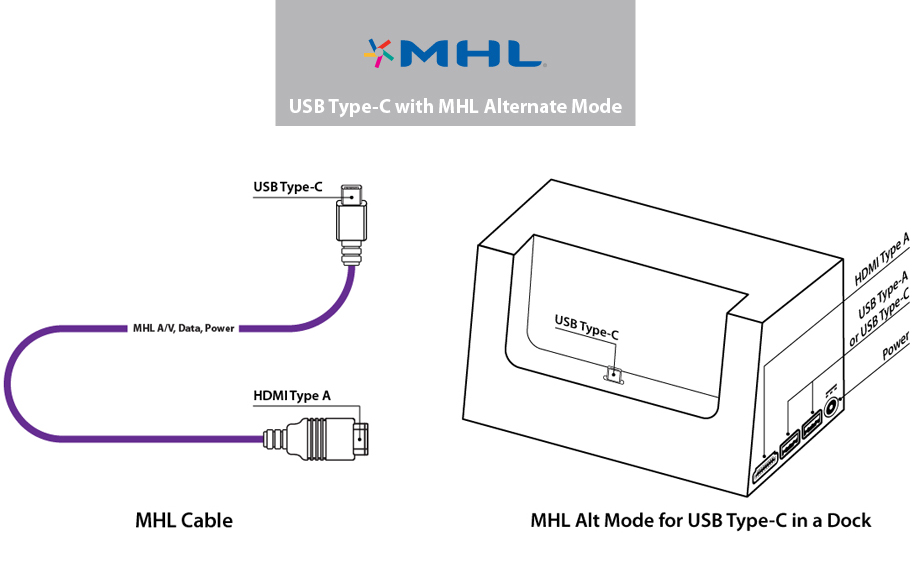MHL Alternate Mode (“Alt Mode”) for USB Type-C Specification
Q: What is the MHL® Alternate Mode (“Alt Mode”) for USB Type-C?
A: MHL, LLC has published a supplement to the MHL 1, 2 and 3 specifications, which
enables devices to transmit MHL (uncompressed audio/video concurrently with USB
data and USB power) over the USB Type-C connector. The supplement covers USB Type-C
to HDMI® Type A cables, USB Type-C protocol conversion adapters (i.e. MHL-to-HDMI)
and MHL Alt Mode for USB Type-C docks.
Q: How can the USB Type-C specification share its interface with MHL?
A: The USB Type-C specification includes an Alternate Mode that enables the multi-purposing
of designated pins in the connector for alternate uses such as MHL. The USB Power
Delivery v2.0 Specification designates how devices can enable Alternate Mode uses.
Q: What are the benefits for Alt Mode on USB Type-C?
A: The USB 3.0 Promoter Group enabled other groups to develop, within their own
specification development processes, separate specifications that are able to use
the USB-defined Alternate Mode. MHL Alt Mode enables a USB Type-C host or device
to support the MHL 3 specification. This benefits consumers and systems designers
because a single connector reduces costs and increases functionality.
Q: Which versions of MHL are supported over the MHL Alt Mode for USB Type-C?
A: The MHL Alt Mode supplement fully supports the MHL 1, 2 and 3 specifications.
Q: Can a user connect a source device that supports USB Type-C MHL Alt Mode
to an MHL display?
A: Yes. Using a USB Type-C to HDMI Type A cable, a user can connect their mobile device to displays supporting MHL.
Q: Can a user connect a source device that supports USB Type-C MHL Alt Mode
to HDMI, DVI and VGA displays?
A: Yes, via a USB Type-C to HDMI, DVI or VGA adapter or dock a user can connect their mobile device to displays with HDMI, DVI or VGA.
Q: Will the reversible feature of USB Type-C connector work with MHL?
A: For USB Type-C cables, the reversible plug orientation and cable direction features
will always be supported regardless of any Alt Modes that are supported by a device.
Additionally, the reversible plug orientation and cable direction features will
not affect the operation of any Alt Modes that are supported by a device.
For USB Type-C adapter/converter cables, the USB Type-C plug will be reversible
in a USB Type-C port, however any reversible-type function of the other end of the
cable is dependent on the capabilities of that technology.
Q: How will I know if the USB Type-C connector on my device supports MHL?
A: The USB-IF is developing joint port identification guidelines to ensure consumers
can identify when an Alt Mode is supported on USB Type-C hosts and devices.
Q: Did MHL work together with the USB 3.0 Promoter Group on developing MHL Alt
Mode on USB Type-C?
A: The MHL Consortium liaised with the USB 3.0 Promoter Group to establish the requirements
that enabled the MHL Consortium to develop the MHL Alt Mode. The USB 3.0 Promoter
Group was not directly involved in the development of this Alternate Mode.
Q: Will products using the MHL Alternate Mode be certified?
A: The USB-IF will be working in conjunction with MHL, LLC to establish complementary
certification and compliance programs to properly support USB Type-C hosts and devices
that incorporate MHL Alt Mode.
